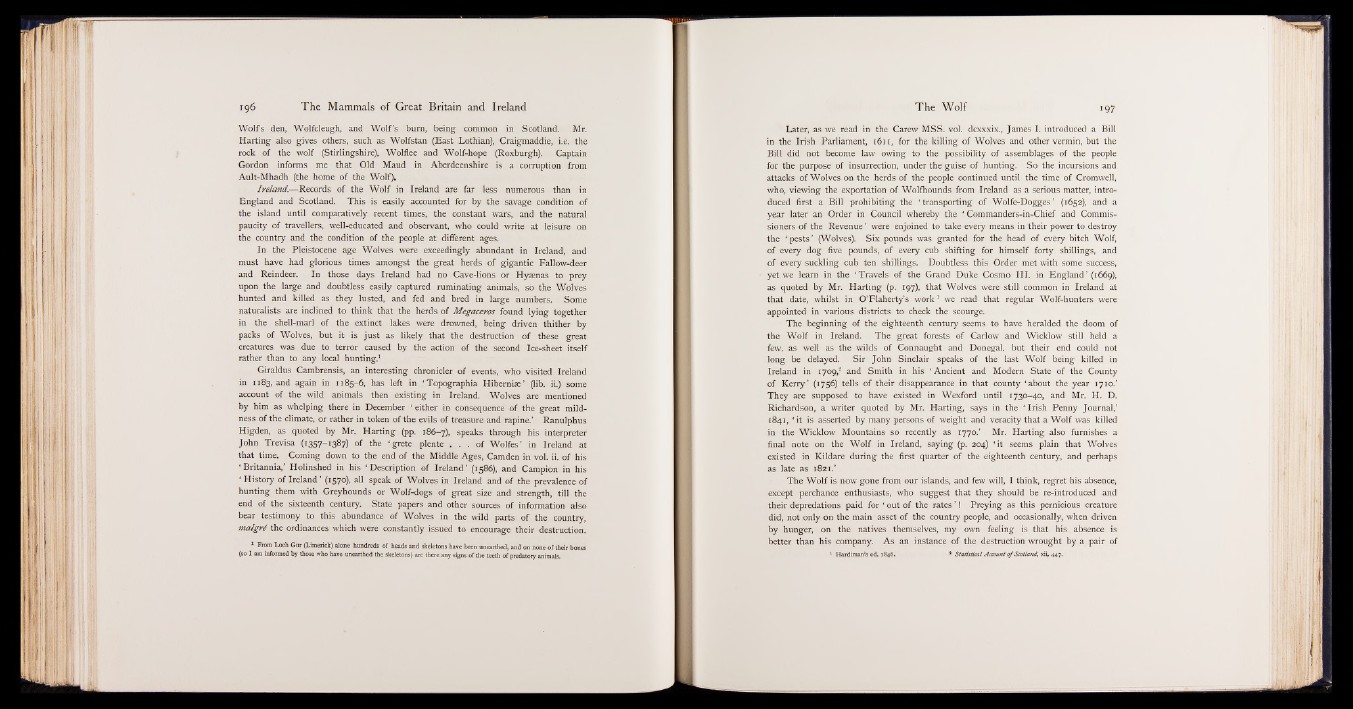
Wolfs den, Wolfcleugh, and Wolf’s burn, being common in Scotland. Mr.
Harting also gives others, such as Wolfstan (East Lothian), Craigmaddie, i.e. the
rock of the wolf (Stirlingshire), Wolflee and Wolf-hope (Roxburgh). Captain
Gordon informs me that Old Maud in Aberdeenshire is a corruption from
Ault-Mhadh (the home of the Wolf).
Ireland.— Records of the Wolf in Ireland are far less numerous than in
England and Scotland. This is easily accounted for by the savage condition of
the island until comparatively recent times, the constant wars, and the natural
paucity of travellers, well-educated and observant, who could write at leisure on
the country and the condition of the people at different ages.
In the Pleistocene age Wolves were exceedingly abundant in Ireland, and
must have had glorious times amongst the great herds of gigantic Fallow-deer
and Reindeer. In those days Ireland had no Cave-lions or Hyænas to prey
upon the large and doubtless easily captured ruminating animals, so the Wolves
hunted and killed as they lusted, and fed and bred in large numbers. Some
naturalists are inclined to think that the herds of Megaceros found lying together
in the shell-marl of the extinct lakes were drowned, being driven thither by
packs of Wolves, but it is just as likely that the destruction of these great
creatures was due to terror caused by the action of the second Ice-sheet itself
rather than to any local hunting.1
Giraldus Cambrensis, an interesting chronicler of events, who visited Ireland
in 1183, and again in 1185-6, has left in ‘ Topographia Hiberniæ’ (lib. ii.) some
account of the wild animals then existing in Ireland. Wolves are mentioned
by him as whelping there in December ‘ either in consequence of the great mildness
of the climate, or rather in token of-the evils of treasure and rapine.’ Ranulphus
Higden, as quoted by Mr. Harting (pp. 186-7), speaks through his interpreter
John Trevisa (1357-1387) of the ‘ grete plente . . . of Wolfes’ in Ireland at
that time. Coming down to the end of the Middle Ages, Camden in vol. ii. of his
‘ Britannia,’ Holinshed in his ‘ Description of Ireland ’ (1586), and Campion in his
‘ History of Ireland ’ (1570), all speak of Wolves in Ireland and of the prevalence of
hunting them with Greyhounds or Wolf-dogs of great size and strength, till the
end of the sixteenth century. State papers and other sources of information also
bear testimony to this abundance of Wolves in the wild parts of the country,
malgré the ordinances which were constantly issued to encourage their destruction.
1 From Loch Gur (Limerick) alone hundreds of heads and skeletons have been unearthed, and on none o f their bones
(so I am informed by those who have unearthed the skeletons) are there any signs of the teeth of predatory animals.
Later, as we read in the Carew MSS. vol. dcxxxix., James I. introduced a Bill
in the Irish Parliament, 1611, for the killing of Wolves and other vermin, but the
Bill did not become law owing to the possibility of assemblages of the people
for the purpose of insurrection, under the guise of hunting. So the incursions and
attacks of Wolves on the herds of the people continued until the time of Cromwell,
who, viewing the exportation of Wolfhounds from Ireland as a serious matter, introduced
first a Bill prohibiting the ‘ transporting of Wolfe-Dogges ’ (1652), and a
year later an Order in Council whereby the ‘ Commanders-in-Chief and Commissioners
of the Revenue ’ were enjoined to take every means in their power to destroy
the ‘ pests’ (Wolves). Six pounds was granted for the head of every bitch Wolf,
of every dog five pounds, of every cub shifting for himself forty shillings, and
of every suckling cub ten shillings. Doubtless this Order met with some success,
yet we learn in the ‘ Travels of the Grand Duke Cosmo III. in England’ (1669),
as quoted by Mr. Harting (p. 197), that Wolves were still common in Ireland at
that date, whilst in O’Flaherty’s work1 we read that regular Wolf-hunters were
appointed in various districts to check the scourge.
The beginning of the eighteenth century seems to have heralded the doom of
the Wolf in Ireland. The great forests of Carlow and Wicklow Still held a
few, as well as the wilds of Connaught and Donegal, but their end could not
long be delayed. Sir John Sinclair speaks of the last Wolf being killed in
Ireland in 1709,2 and Smith in his ‘ Ancient and Modern State of the County
of Kerry’ (1756) tells of their disappearance in that county ‘ about the year 1710.’
They are supposed to have existed in Wexford until 1730-40, and Mr. H. D.
Richardson, a writer quoted by Mr. Harting, says in the ‘ Irish Penny Journal,’
1841, ‘ it is asserted by many persons of weight and veracity that a Wolf was killed
in the Wicklow Mountains so recently as 1770.’ Mr. Harting also furnishes a
final note on the Wolf in Ireland, saying (p. 204) ‘ it seems plain that Wolves
existed in Kildare during the first quarter of the eighteenth century, and perhaps
as late as 1821.’
The Wolf is now gone from our islands, and few will, I think, regret his absence,
except perchance enthusiasts, who suggest that they should be re-introduced and
their depredations paid for ‘ out of the rates ’ ! Preying as this pernicious creature
did, not only on the main asset of the country people, and occasionally, when driven
by hunger, on the natives themselves, my own feeling is that his absence is
better than his company. As an instance of the destruction wrought by a pair of
1 Hardiman’s ed. 1846. 1 Statistical Account of Scotland,* ii. 447.